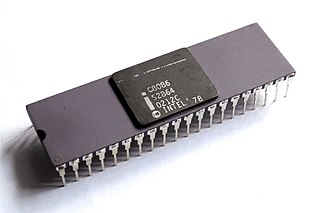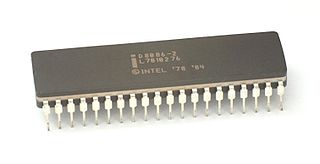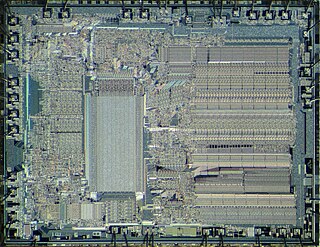Related Research Articles

The Intel 80286 is a 16-bit microprocessor that was introduced on February 1, 1982. It was the first 8086-based CPU with separate, non-multiplexed address and data buses and also the first with memory management and wide protection abilities. The 80286 used approximately 134,000 transistors in its original nMOS (HMOS) incarnation and, just like the contemporary 80186, it can correctly execute most software written for the earlier Intel 8086 and 8088 processors.

The 8086 is a 16-bit microprocessor chip designed by Intel between early 1976 and June 8, 1978, when it was released. The Intel 8088, released July 1, 1979, is a slightly modified chip with an external 8-bit data bus, and is notable as the processor used in the original IBM PC design.

The Intel 8088 microprocessor is a variant of the Intel 8086. Introduced on June 1, 1979, the 8088 has an eight-bit external data bus instead of the 16-bit bus of the 8086. The 16-bit registers and the one megabyte address range are unchanged, however. In fact, according to the Intel documentation, the 8086 and 8088 have the same execution unit (EU)—only the bus interface unit (BIU) is different. The 8088 was used in the original IBM PC and in IBM PC compatible clones.

The Intel 80186, also known as the iAPX 186, or just 186, is a microprocessor and microcontroller introduced in 1982. It was based on the Intel 8086 and, like it, had a 16-bit external data bus multiplexed with a 20-bit address bus. The 80188 variant, with an 8-bit external data bus was also available.

x86 is a family of complex instruction set computer (CISC) instruction set architectures initially developed by Intel based on the 8086 microprocessor and its 8-bit-external-bus variant, the 8088. The 8086 was introduced in 1978 as a fully 16-bit extension of 8-bit Intel's 8080 microprocessor, with memory segmentation as a solution for addressing more memory than can be covered by a plain 16-bit address. The term "x86" came into being because the names of several successors to Intel's 8086 processor end in "86", including the 80186, 80286, 80386 and 80486. Colloquially, their names were "186", "286", "386" and "486".
In computing, protected mode, also called protected virtual address mode, is an operational mode of x86-compatible central processing units (CPUs). It allows system software to use features such as segmentation, virtual memory, paging and safe multi-tasking designed to increase an operating system's control over application software.

A coprocessor is a computer processor used to supplement the functions of the primary processor. Operations performed by the coprocessor may be floating-point arithmetic, graphics, signal processing, string processing, cryptography or I/O interfacing with peripheral devices. By offloading processor-intensive tasks from the main processor, coprocessors can accelerate system performance. Coprocessors allow a line of computers to be customized, so that customers who do not need the extra performance do not need to pay for it.

The NEC V20 is a microprocessor that was designed and produced by NEC. It is both pin compatible and object-code compatible with the Intel 8088, with an instruction set architecture (ISA) similar to that of the Intel 80188 with some extensions. The V20 was introduced in March 1984.

The Intel 8087, announced in 1980, was the first floating-point coprocessor for the 8086 line of microprocessors. The purpose of the chip was to speed up floating-point arithmetic operations, such as addition, subtraction, multiplication, division, and square root. It also computes transcendental functions such as exponential, logarithmic or trigonometric calculations. The performance enhancements were from approximately 20% to over 500%, depending on the specific application. The 8087 could perform about 50,000 FLOPS using around 2.4 watts.

Seattle Computer Products (SCP) was a Tukwila, Washington, microcomputer hardware company which was one of the first manufacturers of computer systems based on the 16-bit Intel 8086 processor. Founded in 1978, SCP began shipping its first S-100 bus 8086 CPU boards to customers in November 1979, about 21 months before IBM introduced its Personal Computer which was based on the slower 8088 and introduced the 8-bit ISA bus. SCP shipped an operating system for that hardware about a year before the release of the PC, which was modified by Microsoft for the PC and renamed IBM PC DOS. SCP was staffed partly by high-school students from nearby communities who soldered and assembled the computers. Some of them would later work for Microsoft.

The Intel 8259 is a programmable interrupt controller (PIC) designed for the Intel 8085 and 8086 microprocessors. The initial part was 8259, a later A suffix version was upward compatible and usable with the 8086 or 8088 processor. The 8259 combines multiple interrupt input sources into a single interrupt output to the host microprocessor, extending the interrupt levels available in a system beyond the one or two levels found on the processor chip. The 8259A was the interrupt controller for the ISA bus in the original IBM PC and IBM PC AT.

The Professional 325 (PRO-325), Professional 350 (PRO-350), and Professional 380 (PRO-380) are PDP-11 compatible microcomputers. The Pro-325/350 were introduced in 1982 and the Pro-380 in 1985 by Digital Equipment Corporation (DEC) as high-end competitors to the IBM PC.
In computer architecture, 16-bit integers, memory addresses, or other data units are those that are 16 bits wide. Also, 16-bit central processing unit (CPU) and arithmetic logic unit (ALU) architectures are those that are based on registers, address buses, or data buses of that size. 16-bit microcomputers are microcomputers that use 16-bit microprocessors.

The Intel 8089 input/output coprocessor was available for use with the 8086/8088 central processor. It was announced in May 1979, but the price was not available at that time. It used the same programming technique as 8087 for input/output operations, such as transfer of data from memory to a peripheral device, and so reducing the load on the CPU. This I/O processor was available in July 1979 for US$194.20 in quantities of 100 or more. Intel second sourced this coprocessor to Fujitsu Limited.

The Intel 8282 is an 8-bit latch, which was developed primarily for the Intel-8086/8087/8088/8089-processors. The component comes in 20-pin DIL package. It was licensed to companies such as NEC and Siemens. With the ROM-less versions of the MCS-48 and MCS-51 microcontroller compact systems with external ROM / EPROM can be realized. The 8282 can also be used in 8080/8085-systems replacing the 8212. If OE is connected to GND, the chip is selected. STB (Strobe) is connected to the pin ALE of the processor and takes over the address data from the multiplexed address-/databus. The 8283 has the same functionality, but the data is inverted. In 1980 the Intel 8282 and I8282 version was available for 5.55 USD and 16.25 USD in quantities of 100 respectively.

The Intel 8283 is an 8-bit latch, which was developed primarily for the Intel-8086/8087/8088/8089-processors. The component comes in 20-pin DIL package. It was licensed i.e. to NEC and Siemens. If OE connected to GND, the chip is selected. STB (Strobe) is connected to the pin ALE of the processor and takes over the address data from the multiplexed address-/databus. The incoming data is inverted – as opposed to the 8282. The Intel 8283 and I8283 version was available for US$5.55 and $16.25 in quantities of 100 respectively.

The Intel 8284 is a clock oscillator chip developed primarily for supplying clock signals for the Intel-8086/8087/8088/8089 series of processors. The commercial variant of the chip comes in 18-pin DIL and 20-pin PLCC packages, and originally was priced at $4.90 USD. The industrial version, rated for the temperatures range of -40 °C to +85 °C was priced at $13.50 USD. The available 82C84A CMOS version was outsourced to Oki Electronic Industry Co., Ltd. The available packaged Intel 82C84A version of 20-pin PLCC in sampling at first quarter of 1986.

The Intel 8288 is a bus controller designed for Intel 8086/8087/8088/8089. The chip is supplied in 20-pin DIP package. The 8086 operate in maximum mode, so they are configured primarily for multiprocessor operation or for working with coprocessors. Necessary control signals are generated by the 8288. It was used in the IBM PC, XT and its clones. IBM PC AT used its successor Intel 82288.
The Intel 80130, referred to as an "Operating System Processor," was developed as a support chip for the 8086/8088 processors and the Intel iRMX86 operating system. Intel referred to the chip as "software in silicon".
In marketing, iAPX was a short lived designation used for several Intel microprocessors, including some 8086 family processors. Not being a simple initialism seems to have confused even Intel's technical writers as can be seen in their iAPX-88 Book where the asterisked expansion shows iAPX to mean Intel Advanced Processor System.
References
- ↑ Intel Corporation, "The 8086 Family: Concepts and realities", Intel Preview Special Issue: 16-Bit Solutions, May/June 1980, Page 19